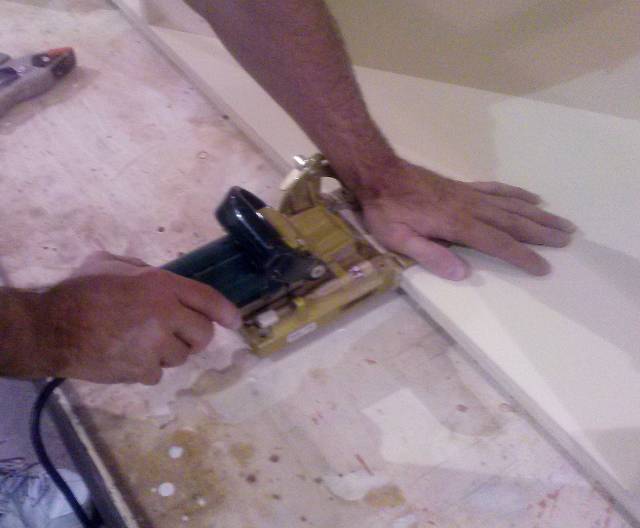17 Replies
Kind of hard to tell somebody how to do something without showing them but I’ll try to add whatever hints I can.
I don’t think adding any fence should be necessary.
I hold mine down flat right on the plate. (see pic)

(some people may not be comfortable holding it like that, but I find it works that way the best for me.) Then make sure you push it in nice and straight without lifting it up or down.
Having your wood clamped down solid will also help.
Just practice, practice, practice
Figuring out how to do something you have never done is what makes a good challenge.
It’s not unusual to see football shaped divits on a table top when they aren’t used correctly. If you put them to close to the surface, the biscuits will swell from the glue, making a raised area. Then, if you sand it smooth before the swelling subsides, it leave a depression shaped like the biscuit. I’m not poo-pooing biscuits, but put them at or below 1/2 way down the thickness, and then let them dry thoroughly before working your table top down.
"I long for the day when coke was a cola and a joint was a bad place to be" Merle Haggartd
I agree with Fred, also there can sometimes be vertical play between the biscuit and the slot which has been cut so when you do glue try and use a clamping caul across the top surface which will hopefully keep the surface flat and keep you from having to do a tremendous amount of sanding.
Ditto what has been said above. I’ve read somewhere that leaving glue off the biscuit and just putting it on the edges of the boards avoids hassles while allowing the biscuit to keep the joint lined up.
Great advice all. The palm trick sounds great.
Losing fingers since 1969
Brian,
I’ve got a tiny (girl-sized) biscuit joiner and I also hold it down with my hand. Another thing that can cause a problem: if the joiner isn’t powered up fully before plunging, it will sometimes lift or move. (I sometimes have a problem with impatience. ) Keep practicing!
L/W
“Those who would give up essential Liberty, to purchase a little temporary Safety, deserve neither Liberty nor Safety.” Benjamin Franklin
I used my biscuit joiner few times on cutting boards and today as a mater of fact.
I was joining to 2 pieces of 2×6 for the bench seats and I wanted to reinforce the edge glue.
I did like Bently showed.
When the pieces are smaller I usually but the against a fence.
I do put the 2 pieces against each other as I would glue them and mark both at the same time. There is always a little play for me. I was told to slightly wet the biscuit so the swell lightly and that should take care of that. I have not tried it.
Abbas, Castro Valley, CA
Practice practice. I guess I’ll practice some more. I want to build a new bench as part of my new shop layout if I ever get around to that. LOL. If I can make that flat I can make my dining table flat.
Losing fingers since 1969
By the way, many of the reviews for the harbor freight joiner said it has excellent dust collection which it really does. I had the vacuum connected to it and there was not a speck of dust anywhere.
Losing fingers since 1969
One other thing, My Biscuit Joiner has a base that is just a little thicker than 3/4" so I have to make sure that my wood is hanging over the edge of the table when I’m doing it.
Figuring out how to do something you have never done is what makes a good challenge.
I try to center the biscuit in the thickness of the material if doing a single row. On thicker stock I’ve done a double row and tried to center the cuts on thirds. As far as spacing, I generally put a biscuit every 4" or so being very mindful of the location of the finished end. Nothing will spoil a nice top quicker than an exposed biscuit on the end.
I have also found some variations in biscuits that can result in less than desirable results. I only buy Porter Cable biscuits. I bought some at Harbor Freight and promptly threw them away.
Artisan Woodworks of Texas- www.awwtx.com
I follow-along with Bill’s advice – center on 3/4", and create a 2nd row on thicker boards. One of the epiphany moments in my biscuit joiner experience is when I realized biscuits do not help align mating boards. I had been relying on the biscuit to provide a smooth surface across the joint, and was frustrated when they’d mismatch. You can get close with creative clamping, but this has nothing to do with the biscuit itself. The Festool Domino is different, in that it does stabilize the alignment; but you need to do a awful lot of joinery to justify one of these…
MJCD
Scratching my head about the doubling up on thicker boards. If the boards are thick, there us a much greater glue surface, which kind of defeats the purpose of the biscuit as I understand it, which is to add strength to joints with high ratio of stress to glue surface. I must be missing something, which wouldn’t be the first time.
Losing fingers since 1969
I can be completely wrong on this, and I don’t want to burden anyone with my understanding, or lack thereof, of the benefits of biscuits.
But here goes;
In my view, Biscuits don’t add significant strength to a joint; and the doubling-up attempts to compensate for this. I can’t speak to Bill’s reasoning; however, I’ve always thought of the biscuit as a helper, not a solution. When you can double-up, you’re adding a little more help.
The whole biscuit premise relies on pulling moisture from the glue, to expand, and fill the void formed by the cutter. So the hydraulic pressure of the expansion is directly related to the amount of moisture available to the biscuit, the swelling-factor of Beech, and the size of the void it has to fill. Beech expands a given amount, and creates a given amount of hydraulic pressure. I’m sure there’s more to it, but this is what I think I know.
Again, I can be way off-base.
MJCD
They certainly do help with alignment. On my first go at it, I was rushing and it still came out pretty OK despite my beeching before. I attributed the misalignment to my shaky Jake operation of the thing.
Losing fingers since 1969
I knocked off the misalignment with my inexpensive jack plane and created a bunch of tear out holes at the same time. LOL out of the frying pan and into the fire. No sweat. I planned on painting it anyway so filler to the rescue after I sand it tonight. I need help with hand planing too but that’s for another forum topic.
Losing fingers since 1969
I’ve always felt that biscuits added to the strength of the joint in the same manner that tenons, dovetails, floating tenons, dominos, and splines do. They all increase the glue surface and serve to “lock” the joint. If you look closely at a biscuit you’ll see that it is actually a lamination and the grain patterns are not perpendicular. This gives the biscuit shear strength. Since it is compressed, the moisture in the glue causes it to swell which “locks” the joint.
The idea behind a double row of biscuits in thicker material, say a table top, is to increase the glue surface area while adding greater mechanical “lock” to the joint. I’ve used this technique in some exterior applications and had some pretty good success. I firmly believe those tops have maintained their integrity based, in large part, on the presence of biscuits.
Artisan Woodworks of Texas- www.awwtx.com















